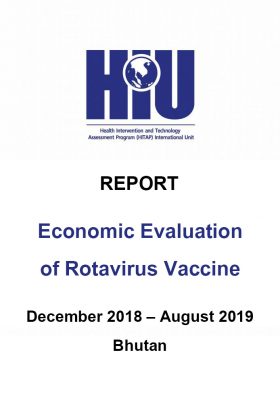This website uses cookies so that we can provide you with the best user experience possible. Cookie information is stored in your browser and performs functions such as recognising you when you return to our website and helping our team to understand which sections of the website you find most interesting and useful.
Economic Evaluation of Rotavirus Vaccine in Bhutan

Details
Bhutan is a rapidly growing economy that is transitioning from international donor support. As such, the country is looking for ways to ensure that they continue to provide the adequate services and support for their population in a rational and sustainable manner. Bhutan has begun using health technology assessment (HTA) as one of the priority-setting tools in the realm of healthcare. Previous collaborations, such as the economic evaluation of pneumococcal conjugate vaccine (PCV) for national implementation, with the Health Intervention and Technology Assessment Program (HITAP) has helped to pave the way for the creation of a process within which evidence can be used for policy making.
At the end of 2018, the High-Level Committee (HLC) of the Bhutanese Ministry of Health (MoH) commissioned an economic evaluation of rotavirus vaccine to explore the options for Bhutan. There is a high disease burden of diarrhea in the country, which is especially problematic for children under the age of 5 (U-5). To reduce the disease burden of diarrhea in the country, the MoH considered introducing a vaccine and commissioned an economic evaluation to assess the economic feasibility of this intervention. The study was conducted over a period of eight months with support from PATH, Seattle, and the International Decision Support Initiative (iDSI). The lead investigator was the Essential Medicines and Technology Division (EMTD) of the Department of Medical Services (DMS) with technical support from PATH, HITAP, and the Mahidol-Oxford Tropical Research Unit (MORU). Two country visits and one study visit to the HITAP offices were facilitated. With the extensive use of local data validated by stakeholders, the study found that rotavirus vaccine was cost-ineffective in the Bhutanese setting at a threshold of 0.5 Gross Domestic Product (GDP)/capita (US$ 1,537 = Nu. 111,908). However, the most promising vaccines among those assessed in terms of cost-effectiveness, ROTAVAC and ROTASIIL, were only cost-effective at a higher threshold. The study also found that human resource needs for nurses and health assistants increased while those for more specialized experts such as doctors and pediatricians decreased.
This study, along with other activities conducted, can help Bhutan to further institutionalize a systematic process for decision-making. During the study, trainings and sensitization workshops at different levels were conducted to increase stakeholders’ knowledge and understanding of the use of evidence and especially HTA. This also helped to generate interest in HTA use and potentially further create demand and supply of researchers to conduct the studies. Stakeholder acceptance and buy-in are key for the growth of this process in Bhutan.
For full report please click here




